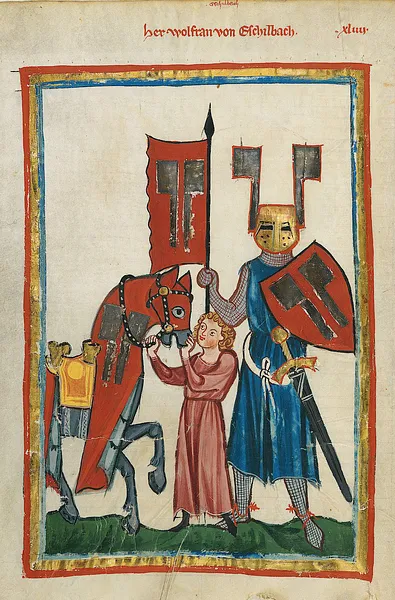From Ancient Origins:
The training to become a knight began as early as the age of seven. Up till then, the child selected to become a knight would be cared for by a foster mother in his father’s castle. Once the child was seven years old, he would be sent to the castle of another knight or lord. These were often relatives of the family, or lords to whom the boy’s father owed allegiance. The boy would serve as a page in the household of his lord. They would begin their service as assistants to squires and would be instructed in various aspects of knighthood.
Physical fitness, combat training , and care for a horse were essential aspects of a page’s training. Of course, these boys would not have fought with real weapons, but with wooden ones. In any case, these lessons were aimed at preparing them for life as a mounted warrior. Apart from that, pages were also instructed in falconry, hunting, dancing, and music, activities that befitted a nobleman. Moreover, the pages received lessons in religion, and were taught reading, writing, and arithmetic. The training of the pages shows that by this time, knights were expected to not only be warriors, but also cultured men of high society.
The training of a page continued until he reached puberty, about the age of 14. By this time, he was no longer considered to be a child, but a young man. A page would be formally promoted to a squire during a religious ceremony. A bishop or a priest would give a consecrated sword to the new squire, who would then swear to use it for honorable purposes or for the defense of the faith.
The training of a squire places much greater emphasis on martial prowess, as they are now mentally and physically prepared for it. This training included combat practice with real weapons, horsemanship, and skills that may come in handy when besieging another castle, including climbing, swimming, and athletics.
The word ‘squire’ is derived from the Old French ‘esquier’ and literally mean ‘shield carrier’. Indeed, one of the jobs of the Medieval squire was to maintain his lord’s weapons and armor, and to ensure that they were in good order. Other tasks performed by squires related to combat included tending to the horses, assisting his lord when he put on his armor, and accompanying his lord to the field of battle in times of war.
Martial training and service, however, was only one aspect of a squire’s life. The squire was not only a warrior-in-training, but also a nobleman, and therefore would have been taught to be one. The squire received lessons in music and dancing, court etiquette, and jousting. In addition, a squire was required to learn the code of chivalry, as well as the rules of heraldry.
Squires also learned to play some popular court games, such as chess, checkers, and backgammon. These games served not only as entertainment, but also as a means to develop strategic thinking.
On top of all this, a squire was also expected to serve in his master’s household, which would have prepared him to manage his own squires should he one day become a lord in his own right.
There were many tasks in a lord’s household that squires could perform. As mentioned earlier, one of the squire’s jobs was the care of his lord’s weapons and armor. This was an important job, as a knight’s equipment was expensive, and proper maintenance was necessary so that it could be used efficiently on the battlefield. Another important task was attending to the lord’s horses, as these mounts were as important to a knight as his armor and weapons. (Read more.)
More HERE.



















No comments:
Post a Comment